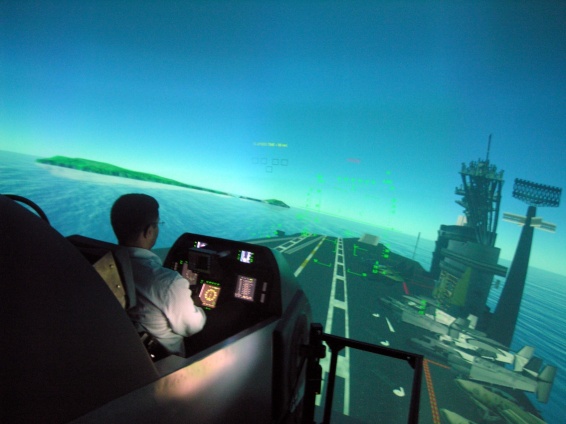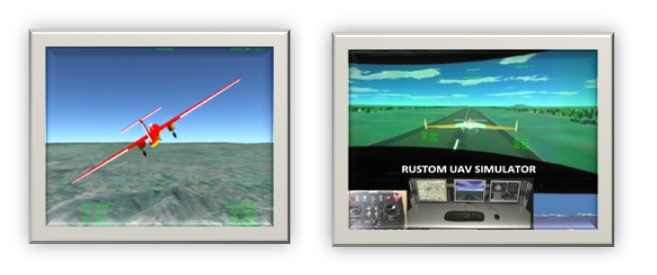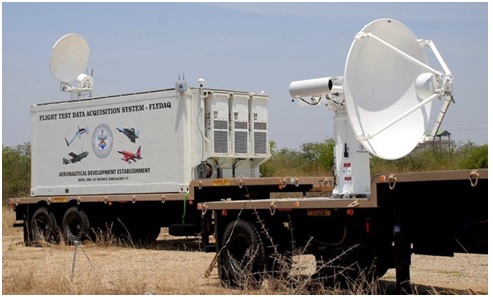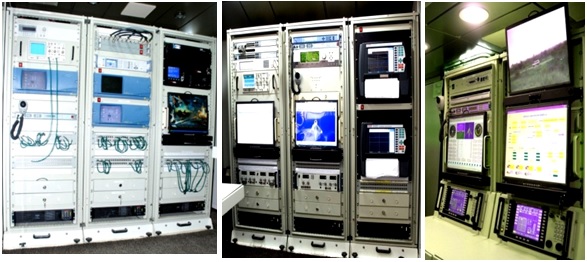Infrastructure Facilities
Facilities Available
Real Time Simulator (RTS) for LCA-Navy
To meet the control Law evaluation requirements of the naval LCA, a dome based RTS facility is set up with a wide visual FOV of 200 deg x 110 deg. RTS simulates the take-off and landing from SBTF and ship deck. The system built on distributed open architecture with extensive use of COTS sub systems to meet the functional requirements of evaluation. RTS was extensively used by the test pilots before the first flight of LCA-Navy.

Real Time Simulator (RTS) – Airforce Variant
To meet the control Law evaluation requirements of the LCA, a dome based RTS facility is set up with a wide visual FOV of 180 deg x 80 deg. RTS simulates the full profile of LCA from take-off to landing, The system is built on distributed open architecture with extensive use of COTS sub systems to meet the functional requirements of evaluation. RTS is extensively used by the test pilots for the control system evaluation. System can be reconfigured for LCA upgrades / variants.
Full Mission Simulator (FMS) for LCA
In order to meet the training needs of the ab-initio pilot of IAF, ADE has upgraded the existing dome based RTS to FMS. The FMS encompasses an aircraft standard cockpit with near real fitments as in the aircraft. The training with start-up procedure to taxiing to execution of the mission to landing is controlled through an Instructor Operator Station (IOS). In addition, IOS would facilitate initiation of different system and sub system level failures such as flight control, engine avionics, electrical system etc. G Seat /Suit fitment provides limited G cueing perceived during the mission.
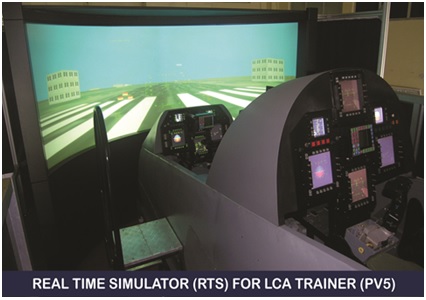
LCA Trainer
A twin seater version of LCA was developed to meet the training needs of the pilots. It was important that the control system was evaluated for this platform before being flown by the pilots. RTS facility was upgraded to meet the LCA trainer requirements. In addition, the force-feel calibration of the front and rear cockpit was fully tested in RTS before its integration on the aircraft. The facility was extensively used both for control law evaluation and mission planning before the first flight and subsequent flights.
UAV Simulator
ADE has developed a state of the art simulation facility for the UAVs, both for flight control system design and evaluation. The facility is also used for External and Internal pilot Training. The development carried out on open architecture has enabled the system to scale up to meet the requirements of most of the UAVs developed in the establishment. The salient features of the simulator are the deterministic real time performance aided by a high speed communication network, a 3 channel projection system with wide field of regard for visual cue presentation and intelligent instructor station for training and debriefing.
Pilot Mental Workload Assessment Simulator
This state-of-the-art facility consists of flight simulator based on Real Time Simulator (RTS) and three channel visual projection display system along with cylindrical screen integrated with other psycho physiological measurement systems are especially established to assess the mental workload of fighter pilots. This facility is used to get a real time data capture for mental workload studies. The data collection is mission &task based and as such would help in building statistical models to arrive at the pilot’s work load for a given task and estimate the spare capacity of the pilot for better utilization.
Aeronautical Test Range (ATR)
ADE is the key Aeronautical Systems Design House in Defence Research and Development Organization. Since its formation in 1959, ADE has been playing an important role in design and development of a variety of aeronautical systems required by the Indian Armed Forces.
To test various Aeronautical Systems being developed by the AERO Cluster laboratories, a dedicated Aeronautical Test Range (ATR) with Air Space was a necessity. ATR at Challakere, Chitradurga is the key facility for integrating and testing various Unmanned Air vehicles before being inducted into the Armed forces and other organisations. This facility is the first of its kind in the country and is a National asset, encompassing 4090 acre for technical infrastructure and 200 acre for Transit & Residential purposes.
The Infrastructure at ATR includes- 1Runway, 3 Taxi Ways, Range Control Center, Two Hangars, Radar center, Fiber Optic Network, Residential Complex, Management block, Technical center, MI Room, Cafeteria, Tech Office, MT yard, SP Vehicle parking area, Creche, Main receiving station with HV DG sets, Substations, Reception, Security, DSC office, DSC accommodation and Watch towers.
ATR was inaugurated by Hon’ble Defence Minister Shri Arun Jaitley on Sunday, 28 May 2017.
Airborne Guidance and Control System (AGCS) for UAV
Important Features
- Command and control of UAV during all Phases of flight
- External pilot console interface
- ATOL interface
- Payload command and control
- Mission planning and validation
- Synchronized flight data recording
LCA-FCS Test System
The Ground based Test system for LCA is a multi-processor system capable of stimulating and monitoring communication interfaces, either in real-time and non-real-time simultaneously. It is used to stimulate the input and simulate output interfaces to the Flight Control Systems before the integration of real interfaces.
The system uses state-of-the art technology to connect the units of Test system and contains a Prime Interface Panel which enables the connection of either real or simulated LRUs to ensure incremental integration of Real Hardware and Software.
The Test system provides extensive software packages, including a terminal based package called as the Advanced Integrated Test Environment System Software that provides commands and facilities for complete management of the Test scripts during the various tests that are conducted on different LRUs of LCA-FCS.
Aircraft Systems Integration Facility
ADE is well equipped with and experienced in aircraft systems integration activities like prototype fabrication of electrical looms, test systems, UAV testing and acceptance using the Flight Line Tester and system integration rigs, electrical wiring and positioning of electrical looms related to air vehicles. ADE is Designing and developing Ground System Equipment, automated test equipment as well as System level test methodology evolution and performance analysis.
Hardware-in-loop Simulation (HILS) Test Rigs
The Hardware-in-loop Simulation (HILS) facility is an important test facility in which the simulated aircraft dynamics activates the actual flight control electronics as well as the associated sensors and control surface actuators in an interactive manner with high degree of fidelity. It is an essential and major tool in design evaluation and analysis of flight control system and optimization of control laws, Flight control hardware-software integration, Verification and validation of integrated flight control software.
Avionics Integration Rigs
AIR is a Ground-based Test Rig for verifying the Integrated Performance of Avionics sub-systems, on ground, before being installed in the aircraft. The connectivity/ interface between the Avionics sub-systems tested at the Rig will be similar to that on the Air Vehicle. Avionics sub-systems and their respective Simulators on multiple interfaces will be integrated at the Rig, with electrical, power and redundancy requirements similar to that in the aircraft. Endurance and Fault Injection Tests are conducted at AIR on the Avionics sub-systems. Post Flight Data can be played back at AIR for detailed analysis of the Flight Data.
Environmental and EMI/EMC Test Facilities
- ADE hasestablishedanEnvironmentalTestfacilitywiththe following capabilities,
- Climatictests(MIL-STD-810G)
- Low/HighTemperature&Thermal Cycling
- ThermalShock
- Humidity
- Altitude
- DynamicTests (MIL-STD-810G)
- Vibration
- Acceleration
- Mechanicalshock
- EMI/EMCTests(MIL-STD-461E/F)
Technical infrastructure for the following EMI/EMC tests as per MIL-STD-461E/F is being established.- CE101
- CE102
- RE101
- RE102
- CS114
- CS115
- CS116
Electronic Engineering Fabrication Facilities
ADE has established a facility for prototype Electronic Engineering with the following capabilities,
- PCBL: The Printed Circuit Board Layout design facility is equipped with EDA tools like ORCAD, PADS for layout design and BETA SOFT for board level thermal analysis.
- PCBF: The Printed Circuit Board Fabrication facility is a modest facility equipped to deliver prototype PCBs featuring up to 4/4 lines/ spaces and 0.3 mm Finished Hole Size (FHS).
- CEFF: The Central ElectronicsFabricationFacilityisestablished with the requisite infrastructure to undertake the following activities.
- Assembly of Printed Circuit Boards with through hole and SMD
- Wiring of Electronic Sub-systems
- Preparation of auxiliary looms, RF Cables
Three-axes Motion Simulator (TAMS) Facility
ADE has set up Three-axes Motion Simulator Facility (TAMS) to test the stabilization performance of GPAs. A Three Axis Motion Simulator (TAMS) is a major system in the R-HILS that provides a platform for mounting the various rate sensors of the FCS. The TAMS is controlled by the HILS software in closed loop operation.
Flight Test Data Acquisition System (FLYDAQ)
FLYDAQ is a state-of-the-art facility developed by ADE for ground telemetry data reception, storage, processing and display. State- of-the-art systems like dual band single axis and dual axis tracking antenna systems, dual band - dual channel telemetry and tracking receivers with built-in diversity combiner and bit-synchronizers, digital data recorders, multiple source data acquisition and distribution systems and capability to process multiple embedded messages make it one of the best telemetry facilities in the country. Station can simultaneously receive and process telemetry and/or video signals in ‘L’ and/ or ‘S’ Telemetry bands. Equipment are housed in rugged EMI/EMC shielded shelters for transportation. Two such mobile telemetry facilities are developed and being used successfully for various manned, unmanned and weapon systems evaluation.
Composites Technology Centre (CTC)
CTC is well equipped with variety of pilot fabrication facilities and cutting edge testing / characterization equipment, some of which are listed below.
Pilot Composite Fabrication Processes
- Autoclave Moulding
- Out-of-Autoclave / Vacuum Bag Moulding
- Match Die Moulding
- Resin Infusion Moulding (RIM)
- Compression Moulding
- Hand lay-up etc.
Fabrication / Related Equipment
- CNC based prepreg cutter
- Cold storage
- Diamond wheel precision composite cutting machine
- Convection ovens
- Autoclave
- Vacuum pumps
- Overhead laser projection system etc.
Characterisation/Testing Facilities
- Ultrasonic NDT Equipment
- Dynamic Mechanical Analyser (DMA)
- Modulated Differential Scanning Calorimeter (MDSC)
- Fourier Transformed Infrared (FTIR) Spectrometer
- Universal Testing Machines with temperature/humidity enclosure (UTM)
- Physical characterisation facilities (viscosity, density, volume fraction etc.)
- Environmental-Ultraviolet conditioning chamber etc.



